Plan A: how Ryder Hesjedal and Garmin won the 2012 Giro
Ryder Hesjedal's victory in the 2012 Giro was a surprise to the cycling world, but not to the Garmin team, who'd planned it in meticulous detail. Here's the story of how Garmin won their first Grand Tour
Words by Edward Pickering
Friday May 3, 2012. This article was first published in Cycle Sport August 2012
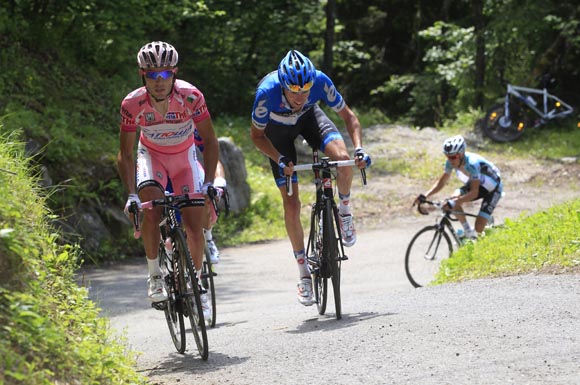
The 2012 Giro was won on the Col du Tourmalet.
Wind back two years, to the final mountain stage of the 2010 Tour de France. In the thick mist at the summit of the Col du Tourmalet, Andy Schleck and Alberto Contador, the two strongest climbers in the race, are fighting out the stage.
Behind them, just over a minute down the mountain, the best of the rest, a fragmenting group of six riders, are wringing the last drops of energy from their bodies on one of the hardest climbs in cycling, with almost three weeks’ racing in their legs. There are no tactics left: the riders will come in today in order of how strong they are.
And look at the rider in fourth place on the line: Ryder Hesjedal, the revelation of the 2010 Tour. In this final contest of brute endurance, the Canadian has been distanced only by Contador (who will later go on to be disqualified for a positive doping test) and Schleck, by a minute. Just one more rider lies a handful of seconds ahead of him. Significantly, for the 2012 Giro, that other rider was Joaquim Rodriguez.
Get The Leadout Newsletter
The latest race content, interviews, features, reviews and expert buying guides, direct to your inbox!
Anybody who was paying attention would realise that Hesjedal is a rider who finishes Grand Tours strongly.
Hesjedal’s Garmin team manager Jonathan Vaughters was paying attention, and last year, he had an idea. At Garmin’s pre-season get-together at the team’s base in Boulder in November, Hesjedal was summoned to a meeting with Vaughters, and managers Allan Peiper and Charly Wegelius. Hesjedal, Vaughters suggested, should lead the team at the Giro. It would involve a complete restructuring of goals and training.
“He wasn’t very keen on it at first,” Vaughters tells Cycle Sport.
“He felt it wasn’t so good for getting ready for the Tour and he didn’t know if he liked the idea. He felt that the Giro was hard, and didn’t believe he could do well there,” he continues.
“I understood his concerns, but I kept on pushing, saying, ‘Ryder, the Giro is suited to you’. We showed him the route and the profiles and he saw that the route was very back-loaded. He knows his body well enough to know what I know – that he’s good at the tail end of a long stage race. It took us about half an hour to convince him.”
Wegelius helped with the persuasion.
“Ryder has been doing the same kind of program for years and years, and when you do something like that successfully it’s not easy to make the mental switch to doing it in any other way. For North American riders, there’s also a natural tendency to focus on the Tour,” Wegelius says. “It took a bit of lobbying to get him on board.”
Vaughters adds, “The good thing about Ryder is that he’s stubborn and he’s a pain in the ass. When you give him advice, he fights it. But once he buys in, he’s not paying lip service, he goes at it 100 per cent.”
Hesjedal bought in. He’d lead the team at the Giro.
Meticulous
The stage one time trial of the 2012 Giro in Herning, Denmark, was one for the purists. Taylor Phinney and Geraint Thomas dominated it, with Garmin’s Rasmussen in third. The top 10 was a rogue’s gallery of meatheads and flat-track bullies.

But was it here that Hesjedal struck his most important blow? He was the best of all the GC contenders, finishing 17th, 29 seconds behind Phinney, but 14 seconds clear of 44th-placed Joaquim Rodriguez. It was a curious event in terms of the final result: of the final top 10, only Hesjedal finished within 30 seconds of Phinney, but it was their times in relation to each other which were important.
“I took a huge boost in morale from that stage,” Hesjedal tells Cycle Sport.
“It was short, but it showed where I was with my legs. I put time into all the other contenders, even if they weren’t looking at me as a contender.”
Garmin also had their secret weapon in Herning: Robby Ketchell, the team’s biomechanist, physiologist, aerodynamicist and nutritionist.
“There was a lot of focus on this prologue,” says Ketchell.
“I’ve never seen Ryder start a time trial like he did this one. Down the ramp, he started fast and was cornering very well. This was the first race he did on the [Cervélo] T5, and he was doing corners in the aero bars that he wouldn’t have done before. He was at one with his bike.
“Before the race we did a lot of TT preparation in Denmark, and he was riding on the TT bike, next to the car and he told me he felt amazing. I knew he’d do a good prologue.”
The other notable thing about the Herning time trial was the performance of Garmin as a whole. Rasmussen was third. Five Garmin riders were in the top 17, and all but one finished in the top 50 — Peter Stetina was 52nd.
The 2012 Garmin Giro squad wasn’t the A-team and, at first sight, it looked light on climbers. But every rider was there for a reason. Hesjedal was there for the general classification, with Christian Vande Velde as his main climbing support.
Vande Velde’s part in the plan was significant — historically he has benefitted from riding two Grand Tours in a season — so he’d support Hesjedal as well as build towards the Tour de France. The other climbing domestique was Peter Stetina, who’d quietly come 21st in his Giro debut the year before.
Tyler Farrar was there for the sprints, although he’d crash out of the race early, while the road captain was Robert Hunter, a master of the dark arts of understanding the dynamics of the peloton.
“He knows the races inside out, and he organises everyone on the road. He’s the link between the riders and the team car,” Wegelius says of Hunter.
“There are things riders like him can feel in the group that you can’t see from the car; he’ll see a team starting to chase, or he’ll have talked to somebody who knows something. He doesn’t mince his words and he’s very clear, which is what you need in a race,” he says.
The rest of the team were what Allan Peiper describes as “musclemen” – Sebastien Rosseler, Ramunas Navardauskas, Jack Bauer and Alex Rasmussen.
“Part of the equation was going with Tyler for stage wins, and strong guys for the TTT,” says Peiper.
“We knew that if we won the TTT we’d be in a good position GC-wise. But the climbers were Vande Velde and Stetina and the rest are musclemen who don’t climb so well. We’d have to ride conservatively and use our resources really wisely.”
Garmin looked like a strong team for the TTT, but surely not a Grand Tour-winning team?
Vaughters disagrees. “We chose a well balanced team. Lots of big strong guys keeping Ryder out of trouble on the flat, with enough climbing talent to support him in the mountains,” he says.
“Getting that balance right is tricky. Everyone looks at Christian and Peter and says that they did the work, but they don’t see the first three hours of the race when Rosseler and the rest are doing their thing.”
There was also one more team member whose selection Vaughters felt was absolutely crucial. “One of our biggest advantages was that we have Charly Wegelius, who is the best neo director I’ve ever seen. He was an everyman rider, and he’s an authoritative leader and strong personality. He has a calm and intelligent way of telling the riders what to do, and they listen intently to him.”
Obsession
While the peloton contested the two road stages in Denmark, Ketchell flew ahead to Verona to make final preparations for the team time trial.
“I was able to drive the course, look at it and nail the final details. I had videos, profiles, terrain and weather reports, and I took it back to show the riders at the meeting. On the rest day we were able to recon it with the entire team, doing rotations, seeing the start and the finish. We could see that the middle was very important, with some big hills,” he says.
Garmin’s attention to detail in team time trials borders on obsession. Every detail is planned and the order of rotation is tweaked, worked on, and perfected. The team practiced standing starts until they could achieve top speed, with everybody in the right place in the line, as quickly as possible. This approach had resulted in a win at the Tour de France last year, and they did the same at the Giro.
But it didn’t all go to plan. Alex Rasmussen, their best rider overall, got tailed off in the tough middle section in the Verona test, and the team had to quickly adjust.
“With TTTs, a lot of people say you can dial in all the details,” says Ketchell. “But it’s also the event with the most variables. When things go wrong, you have to be flexible. Alex still did a great ride and performed for the team, but the hilly section was tough and he had no choice but to sacrifice himself, which was a noble effort,” he continues.

“We had so much strength,” says Hesjedal. “Everyone gave everything, and everybody rode honestly. It’s unfortunate that Alex came off, but we were still fine. We put Ramunas into the pink jersey, and he’s a selfless worker and talented guy. It was a good Giro already.”
Control
Momentum is everything in a Grand Tour. It’s hard-won and easily lost, and it had been uppermost in Wegelius’s mind since that November meeting.
“The biggest concern I had was Denmark,” he says.
“We saw with the start in Holland a couple of years ago what can happen: crosswinds, crashes. When I saw Ryder’s stage one result and how well he came out of Denmark, I knew top five was possible. Some people said his win was because of the team time trial, but what we really did in Denmark and Verona was set a positive tone.
“By getting out of Denmark unscathed and getting the victory in the TTT it set a positive momentum behind the team that continued all the way through the race.”
Garmin showed how confident they had become when Hesjedal took the pink jersey a few days later on stage seven. He’d already missed out on taking the lead when the early break stayed away on stage six, and Adriano Malori stole in front of him, to Hesjedal’s frustration. Stage seven was the first hard uphill finish of the Giro, and Garmin showed how much thought Vaughters and the team managers had put into selecting the team, and how to play to their strengths, in spite of their perceived weakness. Garmin didn’t have a full team of climbing domestiques, so they exploited their strength on the flat instead.
“We had a team that was able to go at 55 kilometres per hour to the base of the climbs, and that put us one step ahead of the other leaders. They were stuck 50 riders back and having to close gaps on the climbs,” Vaughters explains.
It wasn’t just a case of being able to hammer to the climbs, either. The pacing has to be more finely-judged than, say, a sprint lead-out, and one rider in particular was very good at it.
“Alex Rasmussen is a brilliant time triallist. But he rides on the track, too. He can ride in the wind all day, but he has that smoothness of acceleration from the track, so he can ride on the front without putting a climber into difficulty,” explains Wegelius.
“When you work with riders used to leading out sprints and ask them to place a climber in a good position, it’s not the same thing. You don’t deliver the guy to the bottom at full sprint, for him to do 15 seconds all out — he’s got to keep going for an hour.
“The acceleration has to be smooth and soft. Smooth and soft. Imagine you are passing a crystal vase to the next rider. Alex is good for that.”
Garmin went to the front of stage seven with 40 kilometres to go, and led the bunch to the base of the climb to the finish at Rocca di Cambio.
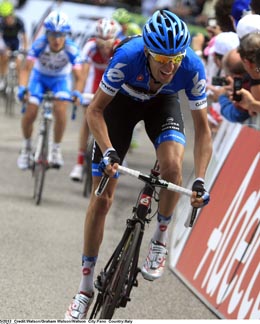
“We had it lined out, slightly downhill, dust coming off the road at 65 kilometres per hour, and our guys were drilling it,” says Peiper.
“We’d done some recon of the final, and Vande Velde knew to lead into the downhill before the kick-up with 1,300 metres to go. Ryder turned into the corner first and got a gap. He got caught, but got his breath to hang on and stay with them to the line and take the jersey. We talk about him winning the Giro by 16 seconds but we could have lost 16 seconds on that single day, just by not having the team do what we did, or not doing the recon.
“Christian said that evening that it might have been Garmin’s finest ever day. We controlled it, set Ryder up and he took the jersey.”
Winning mentality
Hesjedal and Rodriguez spent the next week and a half swapping the pink jersey back and forth, never separated by more than a handful of seconds.
The parcours favoured one, then the other. Stage 10, with a violently steep uphill finish in Assisi, was perfectly suited to Rodriguez, and the Spaniard took the pink jersey, in spite of another well-executed lead into the climb by Garmin, which kept Hesjedal close behind. Four stages later, Hesjedal took the lead back with an aggressive, well-timed, clever and strong move on the climb to Cervinia.
Before this stage, Hesjedal had looked like a good rider who’d taken advantage of favourable terrain to keep his place in the top three. After this stage, he looked like a potential winner, and his rivals should have known it.
“It was hugely important. If I hadn’t gained those 26 seconds, who knows what would have happened?” Hesjedal asks.
“I did it based on feeling. I was looking around, waiting for the attacks, and they weren’t happening. My legs were good, so I tried.”
At the time, it looked like his rivals might not have been too worried about him going away from them.
“If anybody had more to give on that climb and they didn’t chase, they made a big mistake,” Hesjedal says bluntly. “I did my race, I took my chances, and I won. That’s why you have a race. People might have been thinking they would drop me in a few days, and if they did, that’s fine. But if they did, then they miscalculated.”
Hesjedal was growing in confidence and stature as he pulled on the pink jersey that evening, and Wegelius was starting to think that aiming for the top five was setting their sights a little low, but that they still had to be careful.
“I got to the team bus and had to ride a bike up the final kilometre to take Ryder’s recuperation drink to him. I remember riding up thinking, ‘this is brilliant, but now we have to calm him down and make sure we think rationally, and cold-blooded,’” says Wegelius.
“I was working out in my head how to keep him calm without putting a downer on the whole thing, how to tell him that it wasn’t necessary to defend the jersey, but in a way that wouldn’t demoralise him.
“I got to him, and he said, ‘we don’t need to do anything. It’s the other guys’ race to lose.’ He had the coolest head of all of us!”
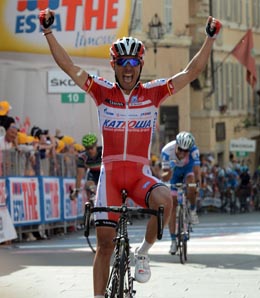
And then Rodriguez took the jersey back the very next day on the steep final climb to Lecco.
“That was my bad day,” reveals Hesjedal. “There was bad weather, I was defending the jersey, having to take responsibility on a hard day. I had a couple of bike changes and rode my spare bike for the first time. These little things add up.”
Hesjedal finished the day 30 seconds down overall. With three very hard mountain stages to come, Rodriguez was the favourite again.
Robust
It was actually Ivan Basso who was riding the most like a favourite, well into the final week of the Giro. Day after day, he set his Liquigas climbing domestiques, probably the best in the race, to work. They burned off everybody except Basso and his strongest rivals, but the 2010 winner was unable to take advantage of their work.
In fact, through the race, Garmin had been careful to conserve their resources.
“The team never panicked or used too much energy,” says Vaughters. “We put ourselves in the position to use energy if necessary, but the riders were metering it out just enough, and never overcooking it.”
The Liquigas mountain tactics suited Hesjedal perfectly, and took the pressure off Garmin having to dictate the pace in the mountains when they were short-staffed.
“Basso continued his strategy of making the race hard. I think he wanted to keep himself in the picture,” reflects Hesjedal. “Liquigas did all the damage on the climbs, but every time Basso accelerated, I was able to respond.”
On the surface, the tactics looked nonsensical, especially seen in the harsh light of hindsight. But in Vaughters’ opinion, they had no choice.
“The only way for Basso to win is to keep a high sustained pace for long periods of time, and then he can grind everyone’s legs off, like he did in 2010,” he says.
“Liquigas had to do that, it’s the only tactic they have, and their team was built for it. We didn’t play off them, but we knew what they were doing.”
On the stage to Cortina d’Ampezzo, Liquigas had stifled the race, while Hesjedal and Rodriguez matched each other on the climb. It looked like stalemate, but with the fearsome climbs of Alpe di Pampeago and the Stelvio to come, it was hard to see Hesjedal matching Rodriguez. Except for one thing: Garmin’s final trump card.
“I’ve got more info than you guys on Ryder’s physiology,” Jonathan Vaughters tells Cycle Sport.
“And the thing that’s interesting about him is that as he gets fatigued, his power levels don’t drop off. So if you can find a race that’s going to be decided in the third week, he’ll be good at it.
“When we saw the Giro, we said, ‘wow, the Stelvio with two days to go, and a time trial... it’s loaded in the back end’. In a weeklong race, Ryder can get top 10, but he’s not great at those because he’s a diesel. Basically, he won the Giro because he out-dieseled everybody. He wasn’t spectacular anywhere, but he never faltered, while everybody else was getting fatigued.
“He also has an incredible capacity to absorb hard work. Some riders have a high VO2 Max, me for example. But I never had the ability to absorb work – I always got sick or injured. Some riders can be under-23 world champ, and have real talent given a certain training load. But when they go from 22,000 kilometres a year as an under-23, to 32,000 kilometres a year as a pro, they break down.
“Ryder’s talent isn’t his lab value, but from an immunological and hormonal perspective, his body is robust. He has to train more to get there, but he’s one of the few riders who, the harder he trains, the faster he goes.”
Pampeago plan
Alpe di Pampeago, the finish of stage 19, left Allan Peiper with two striking memories of Hesjedal’s Giro, one before the stage, one towards the end.

“The night before Pampeago, in the team hotel, I was watching Ryder. The staff were eating on one table, the riders on another, and he was turned 90 degrees from me.
“He knew I was looking, and he turned his head towards me, and he gave me this little smile and nodded his head ever so slightly, like, ‘It’s going to be OK,’
“The confidence was dripping off him. He knew he was good, and he knew what he could do.”
Hesjedal turned the race on its head on Alpe di Pampeago. Pundits speculated about how much time he would cede to Rodriguez on its steep slopes, which on the surface, suited the Spaniard more than the Canadian. Rodriguez himself probably anticipated this being a climb on which he could win the Giro. But none of them took into account the fact that the race was almost three weeks old. Any advantage Rodriguez had would be negated by Hesjedal’s extraordinary stamina.
“I knew they had to do something to me on the climb, and all I had to do was watch out for the attacks and respond,” says Hesjedal.
“Scarponi did many attacks and I was able to respond. I knew I had the strength in my legs — that’s the time to give it some, and see what’s happening. So I did. I really gave it some — at that point there’s not a whole lot to it.”
Hesjedal’s attack on Alpe di Pampeago put him 13 seconds closer to Rodriguez, just 17 seconds behind the Spaniard overall.
It was at the moment of Hesjedal’s attack that Peiper became convinced he would win the Giro.
“There was a tunnel with 500 metres to go, and I saw the picture of him coming out of the tunnel, like a classic ride from the old days. I could see his silhouette, and the light around him. I could see his style. He really put his stamp on the race then.”
Twisted tactics
Stage 20 of the 2012 Giro, to the summit of the Stelvio, was one of the finest day’s racing in the last decade, a reprise of Cadel Evans and Andy Schleck’s duel on the Col du Galibier in last year’s Tour, but with more tactical finesse. It was a stage in which only the strongest riders could hope to survive yet it was raced in a very tactical way.
The stage crossed some early climbs, then the very steep Mortirolo, before a long valley drag up to the base of the Stelvio. There were several tactics being employed, some of which looked well-planned, others of which looked hastily improvised.
“I know what it feels like as a rider to sit on the bus on the morning of stage 20,” says Wegelius. “I told the guys all they needed to do was be a little more special for a few hours. I knew his rivals would throw everything at us. I could see the reactions to Hesjedal’s ride on Pampeago.
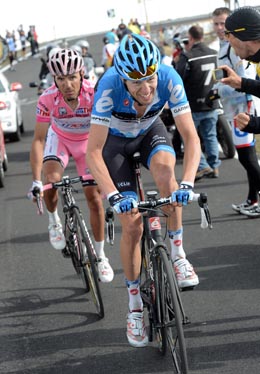
“In Italy, a lot of the race is played out through the press. People make statements, knowing everyone will read it, and it’s a dance. I got worried when I read people saying they were riding for second, and that Hesjedal was the strongest. It was very flattering, but it meant they wanted us to ride, to defend. And our team wasn’t balanced for a hard stage like that.”
Christian Vande Velde joined the early attack, yet Peiper and Wegelius made Garmin ride on the front of the bunch. They didn’t want Vande Velde too far ahead, so that they could call him back if they needed him. Thomas De Gendt of Vacansoleil attacked over the Mortirolo and joined up with his team-mate Marco Carrara who’d also escaped earlier in the day. As the Belgian stretched away, Hesjedal suddenly looked isolated; with Vande Velde ahead, and Stetina getting dropped on the Mortirolo, his rivals hung him out to dry. Rodriguez didn’t chase, nor did Scarponi, who at least had the excuse of his team-mate Cunego also being in the escape. De Gendt’s lead stretched to over five minutes at one point; he was threatening to win overall, and still Rodriguez and Katusha wouldn’t chase.
“After the Mortirolo, we had to regroup,” says Peiper. “De Gendt attacked, Peter Stetina was off the back, and everybody looked at Ryder, while they rode at 15 kilometres per hour. We pulled back Christian and we waited for Peter to catch back, which gave De Gendt minutes. But we needed both guys – with any less, we wouldn’t have won the Giro. Katusha were prepared to lose rather than ride, and they were prepared to lose, rather than let Ryder win.”
Once Vande Velde and Stetina were both with Hesjedal, which took longer than hoped when the younger rider punctured and had to chase on for the second time, Garmin went to work. Stetina got them into the Stelvio climb, then Vande Velde took over.
Vande Velde, in Wegelius’s opinion, was key to Hesjedal’s win, both for the work he did on the road, but also the work he did before and after the stages.
“Christian was a rock,” says Wegelius. “He’s really helpful – he’s the nagging voice in Ryder’s ear, keeping him awake. In those races, you can’t sit at the back of the group for five minutes, so Christian kept nudging him. Hearing it from him gives it extra value because he’s so experienced.”
As Garmin set about rescuing the race on the Stelvio, the riders knew that the next 45 minutes would decide the destiny of the pink jersey.
“It was now our race to lose,” said Hesjedal. “Christian was crucial. Every pedal stroke that he and Peter did that day was part of my win.”
Peiper was anxiously watching from the team car.
“Christian got us to halfway,” he says. “At that point, it could unfold in a lot of ways, but we remembered Evans riding with courage on the Galibier. We talked about that in the car when Ryder was left on his own.’”
Wegelius wanted Hesjedal to leave it as late as possible before committing himself fully.
“We waited as long as we dared, and said, you’ve got to ride now. Ride in the gutter to make them suffer in the wind, and ride a time trial to the finish. Don’t turn around. Rodriguez isn’t attacking you now, because he can’t,” says Wegelius.
The closer Hesjedal got to the finish without Rodriguez attacking, the better it was. With 800 metres to go, the Katusha rider went for it. “Rodriguez, to his credit, threw everything he had at Ryder at the end,” says Peiper.
The brave Spaniard gained 14 seconds, but he must have known it wouldn’t be enough.
Narrow margin
If Hesjedal had been the epitome of cool throughout the Giro, he finally woke up nervous on the morning of the final stage. “He was more nervous than I’d ever seen,” says Peiper. “That’s a good thing. He was on his game.”
Robby Ketchell had gone to the USA after the team time trial, to work with Garmin at the Tour of California. But he had one last job to do in Italy, and he flew to Milan to help Hesjedal’s final effort of the race: the stage 21 time trial.
“I got to Milan and started reconning the time trial course,” says Ketchell.
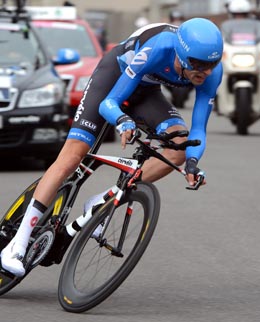
“It was like a giant prologue – unlike most time trials, it was in a city, so there were a lot of corners. People were saying Ryder could gain three minutes, but I could see that wouldn’t happen. In a straight out-and-back course it would be just him against his competitors, but there were more variables here.
“It wasn’t a time trial we were able to ride in advance — there are lots of one-way streets, and lots of cars. But I walked around a lot of it, marking down the critical points, which corners he could go full speed through, where to be careful, and where the wind was going to blow from. We were able to communicate that to him through the race and that was critical.”
The team used the splits from the riders who set off early in the day to guide them for Hesjedal’s effort. The most technical section was at the start, and that’s where the time was being gained.
“Ryder took 28 seconds out of Rodriguez in the first 10k,” says Peiper.
That left him only three more needed to win, and while Rodriguez fought hard, Hesjedal did enough to win the Giro by 16 seconds.
With margins that tight, it’s impossible to say where the Giro was won and lost. The lead swung back and forth so much that it looked almost like an equal fight. But Hesjedal dominated the final three mountain stages and the time trial. If his rivals wanted to beat him, they had to put him out of the race before his ascendancy in the final week. Hesjedal underlines his consistency over three weeks when he points out an unusual symmetry in his win: “It’s a complete three-week race, and I took the pink jersey on stage seven, stage 14 and stage 21.”
THE GENERAL CLASSIFICATION
How the GC evolved over three weeks
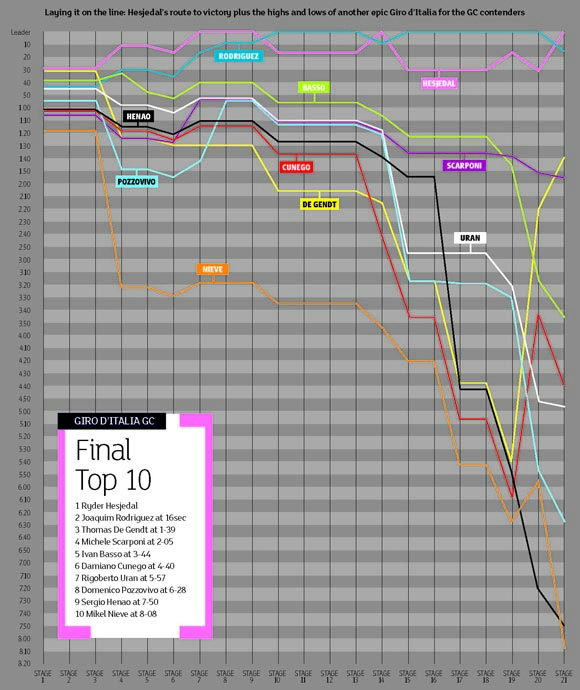
THE CLOSEST GRAND TOURS IN HISTORY

THE GIRO 2012 SWINGOMETER
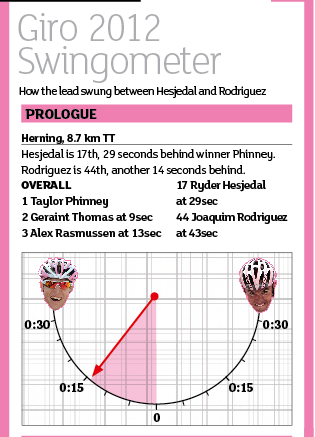
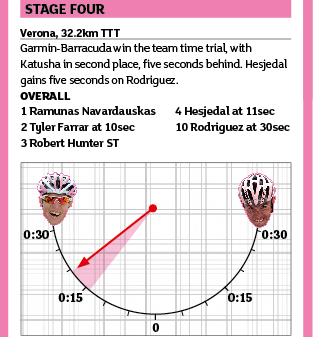
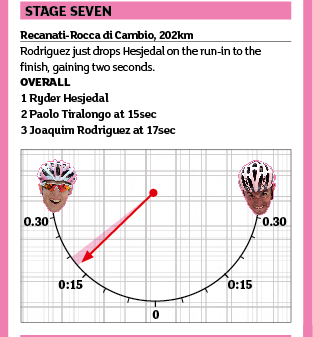
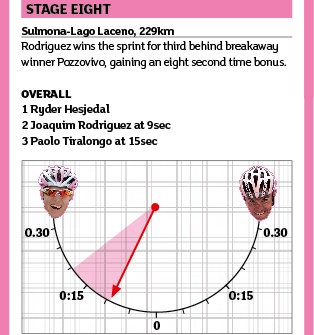
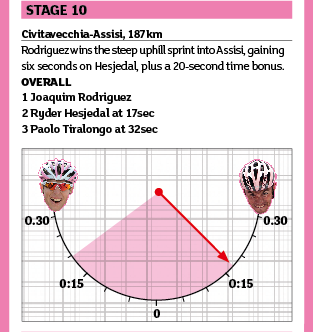



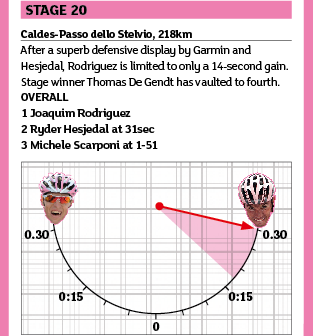
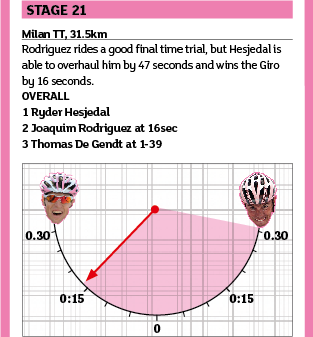

Thank you for reading 20 articles this month* Join now for unlimited access
Enjoy your first month for just £1 / $1 / €1
*Read 5 free articles per month without a subscription

Join now for unlimited access
Try first month for just £1 / $1 / €1
Edward Pickering is a writer and journalist, editor of Pro Cycling and previous deputy editor of Cycle Sport. As well as contributing to Cycling Weekly, he has also written for the likes of the New York Times. His book, The Race Against Time, saw him shortlisted for Best New Writer at the British Sports Book Awards. A self-confessed 'fair weather cyclist', Pickering also enjoys running.
-
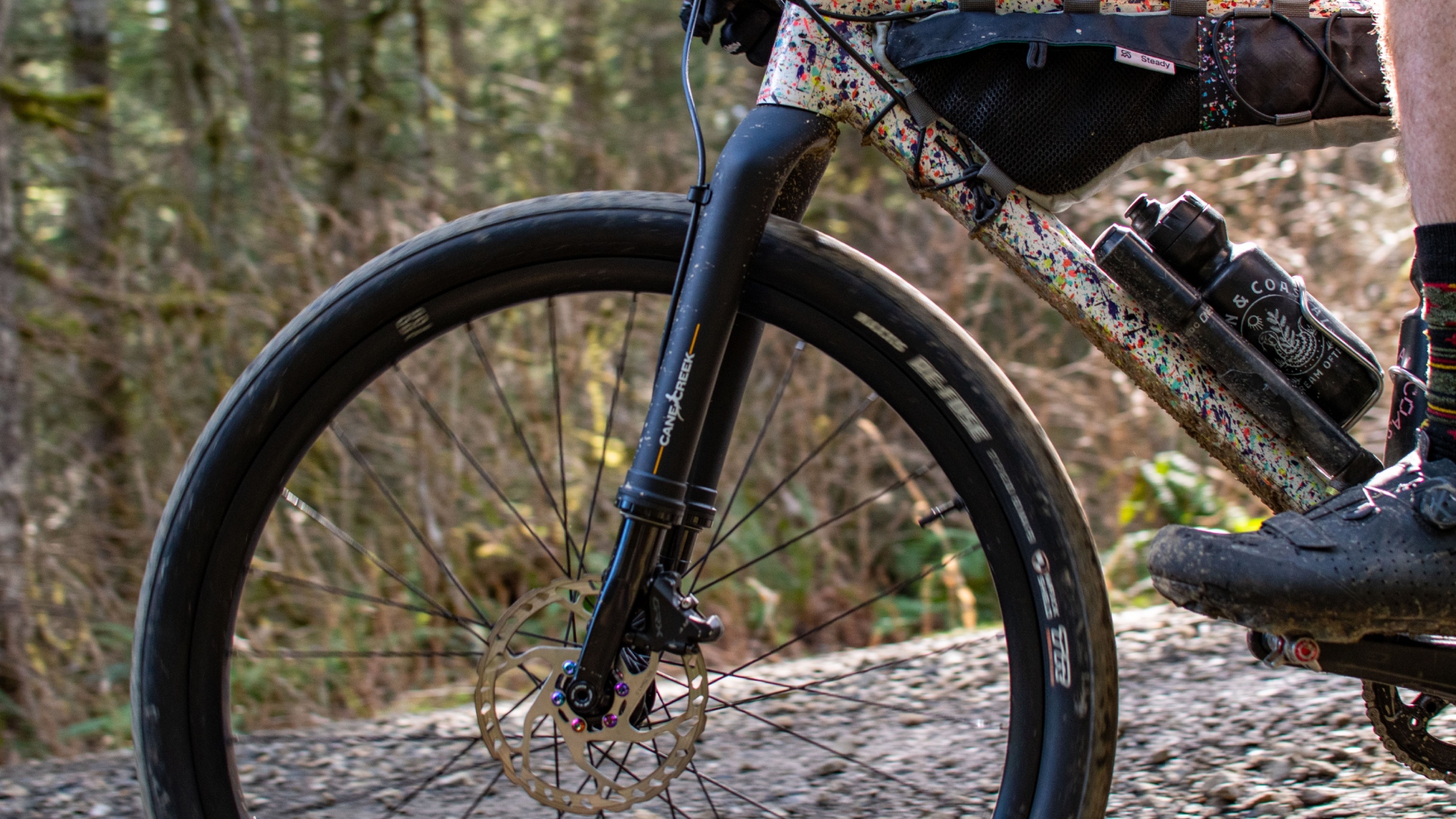 Review: Cane Creek says it made the world’s first gravel fork — but what is a gravel fork, and how does it ride?
Review: Cane Creek says it made the world’s first gravel fork — but what is a gravel fork, and how does it ride?Cane Creek claims its new fork covers the gravel category better than the mini MTB forks from RockShox and Fox, but at this price, we expected more.
By Charlie Kohlmeier
-
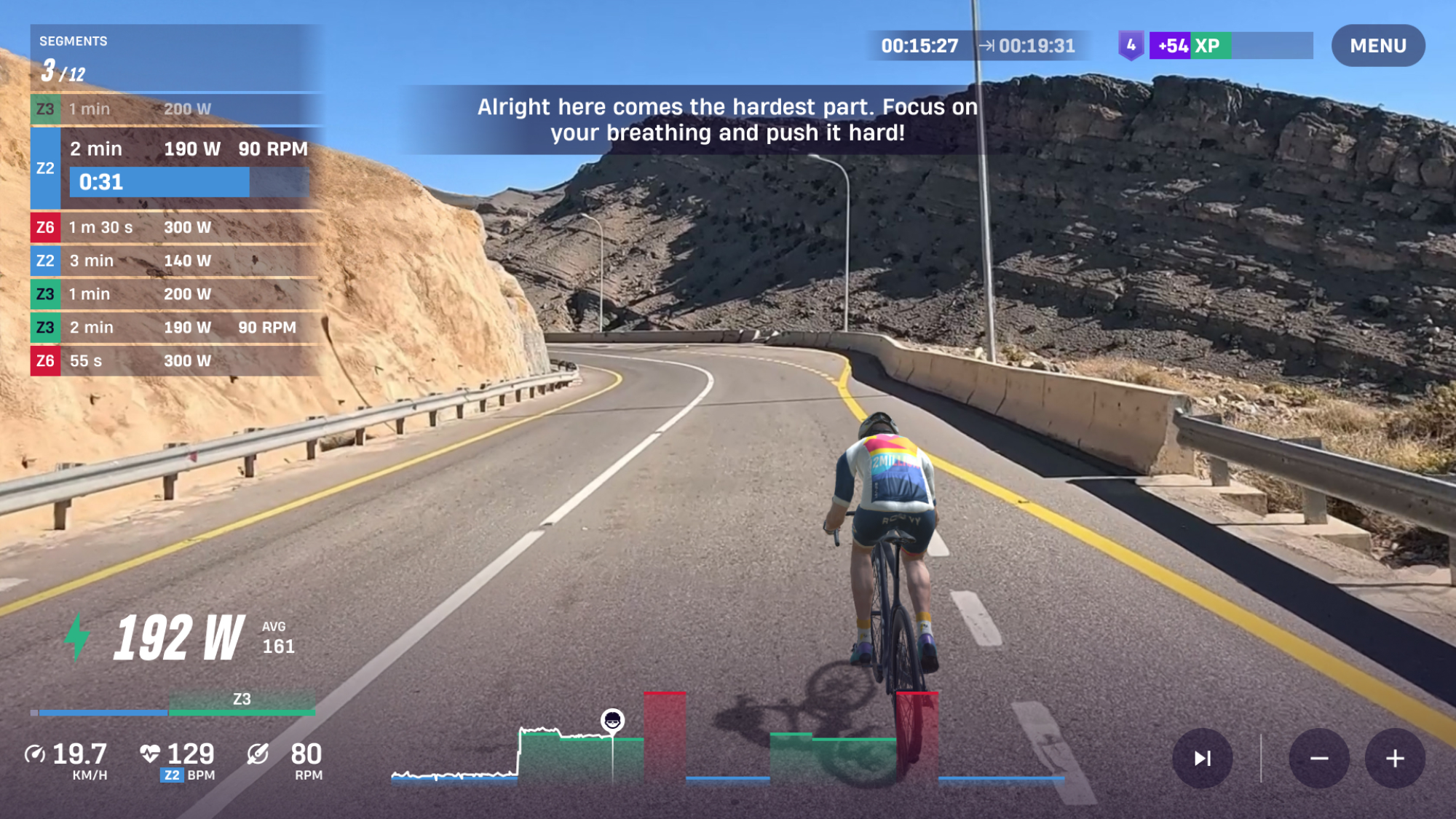 ROUVY's augmented reality Route Creator platform is now available to everyone
ROUVY's augmented reality Route Creator platform is now available to everyoneRoute Creator allows you to map out your home roads using a camera, and then ride them from your living room
By Joe Baker
-
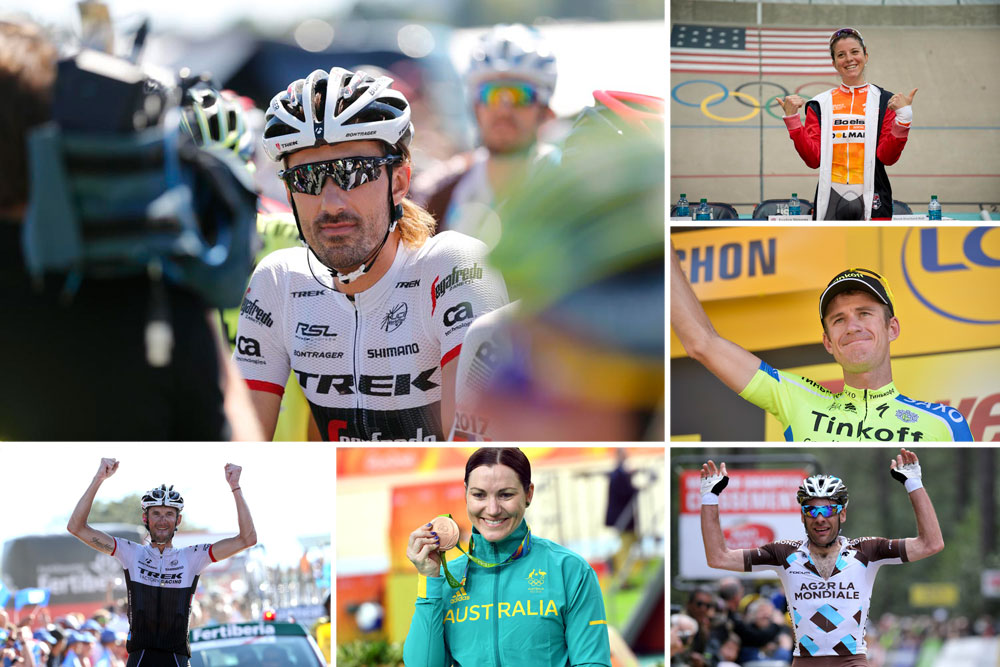 11 notable pro riders who have retired in 2016
11 notable pro riders who have retired in 2016We list some of the notable professional cyclists who have hung up their wheels and will not be joining the peloton in 2017
By Stephen Puddicombe
-
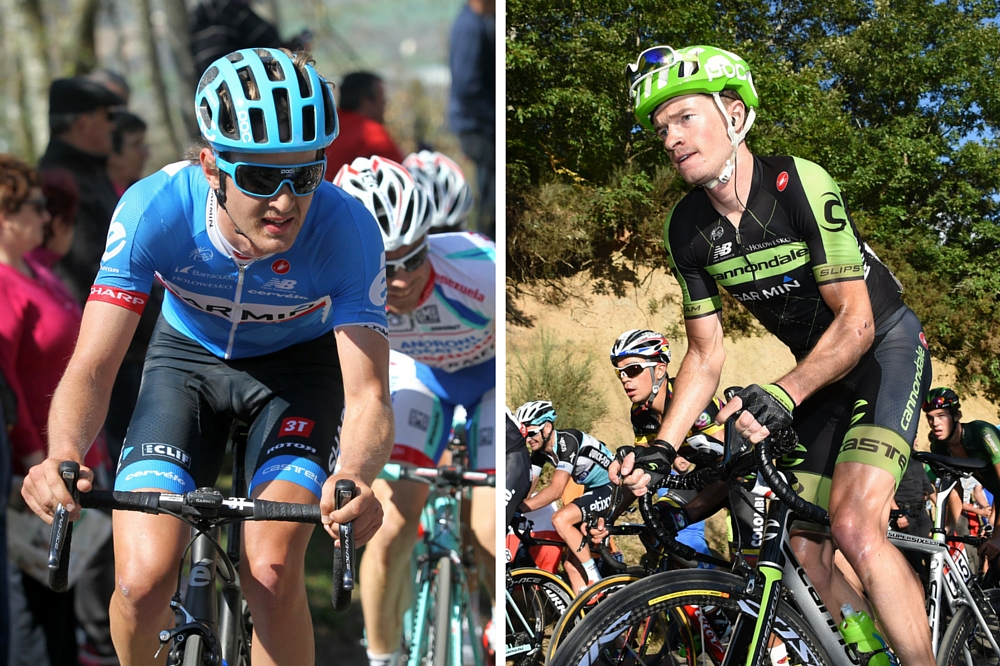 Cannondale-Garmin reveals Jonathan Vaughters's mystery signings
Cannondale-Garmin reveals Jonathan Vaughters's mystery signingsCannondale-Garmin announced the signing of Phil Gaimon and and re-signing of Ben King on Friday following Jonathan Vaughters' cryptic tweet on Thursday afternoon
By Cycling Weekly
-
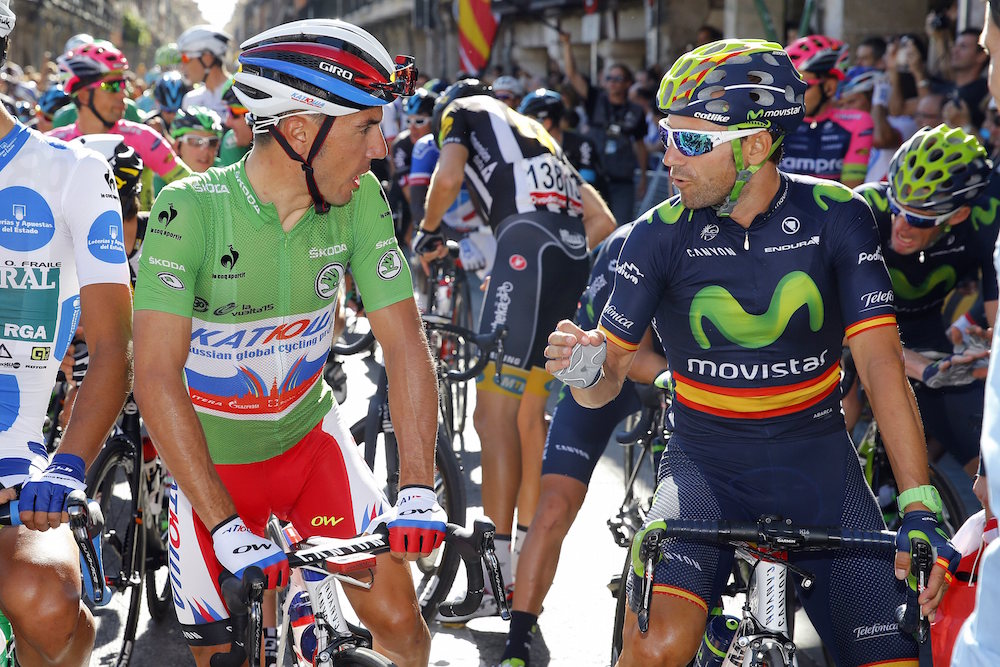 Spanish coach plays down speculation of Worlds rivalry between Valverde and Rodriguez
Spanish coach plays down speculation of Worlds rivalry between Valverde and RodriguezAlejandro Valverde stole the Vuelta a España points jersey from Joaquim Rodriguez on stage 21 when Purito had a puncture before the sprint
By Stuart Clarke
-
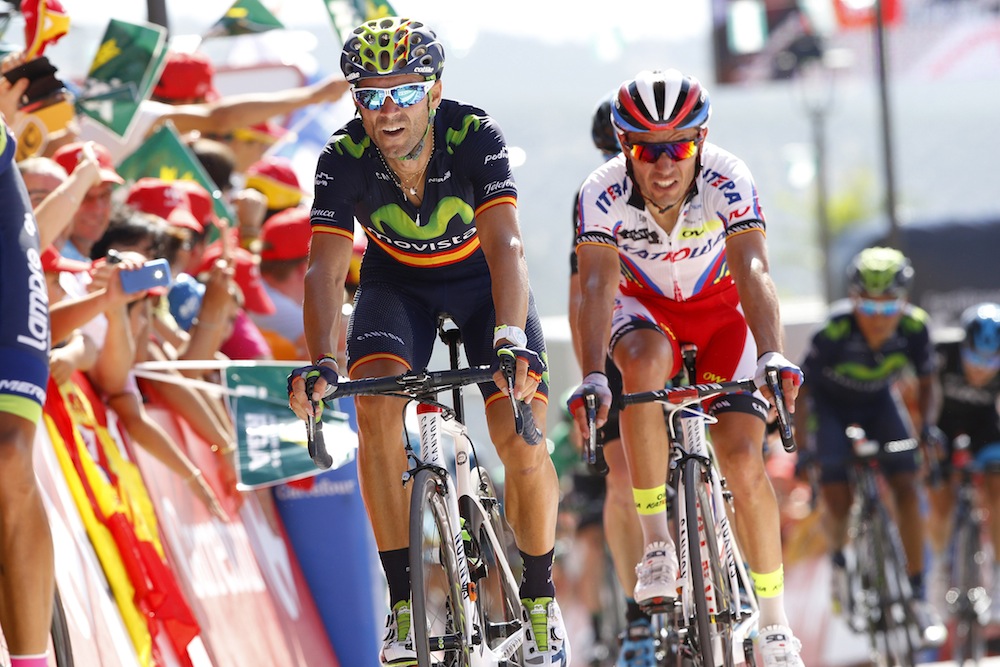 Valverde and Rodriguez on Spain longlist for World Championships
Valverde and Rodriguez on Spain longlist for World ChampionshipsSeven Movistar riders named on the Spain longlist for the World Championships in Richmond, Virginia, at the end of September
By Stuart Clarke
-
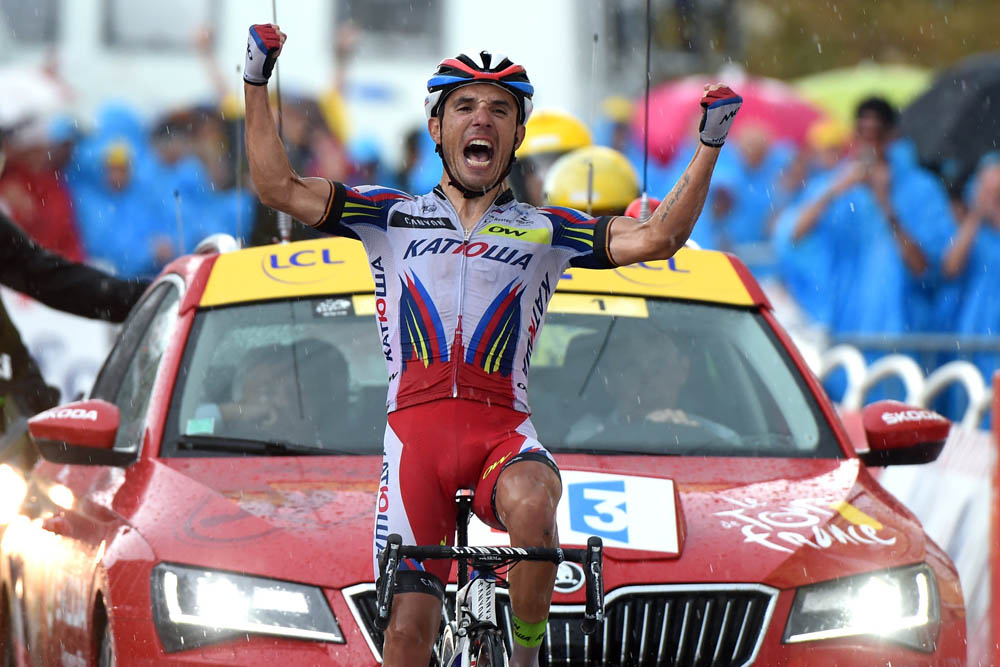 Joaquim Rodriguez renews contract with Katusha for another year
Joaquim Rodriguez renews contract with Katusha for another yearKatusha pen double Tour de France stage winner Joaquim Rodriguez to a one-year contract, keeping him at the team for his seventh season
By Stuart Clarke
-
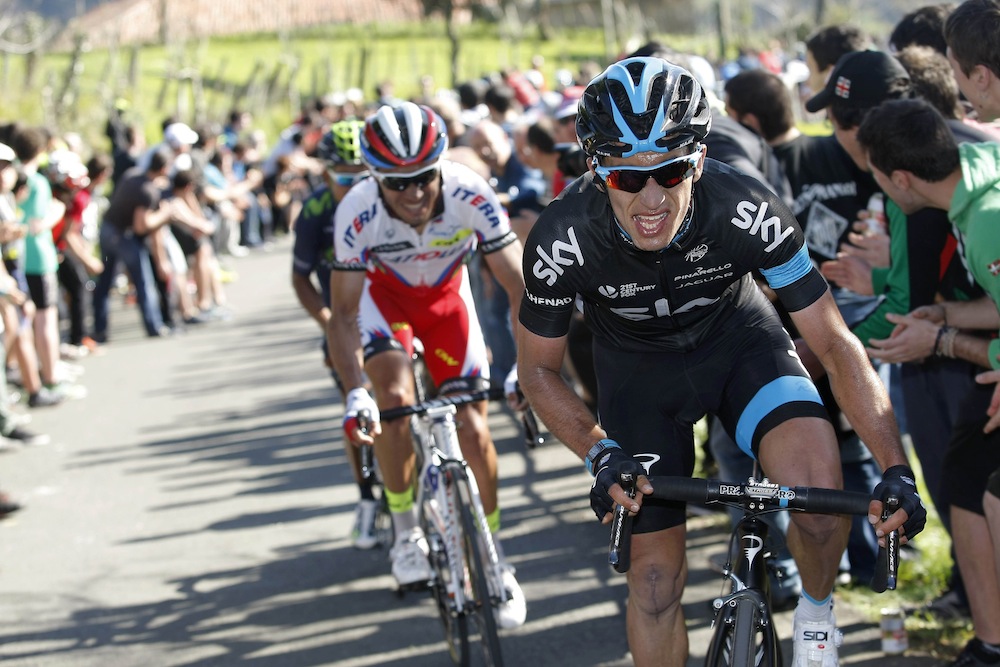 Joaquim Rodriguez pips Sergio Henao to win Tour of the Basque Country stage three
Joaquim Rodriguez pips Sergio Henao to win Tour of the Basque Country stage threeSergio Henao finishes second in Zumarraga as Joaquim Rodriguez takes stage three of the Tour of the Basque Country
By Stuart Clarke
-
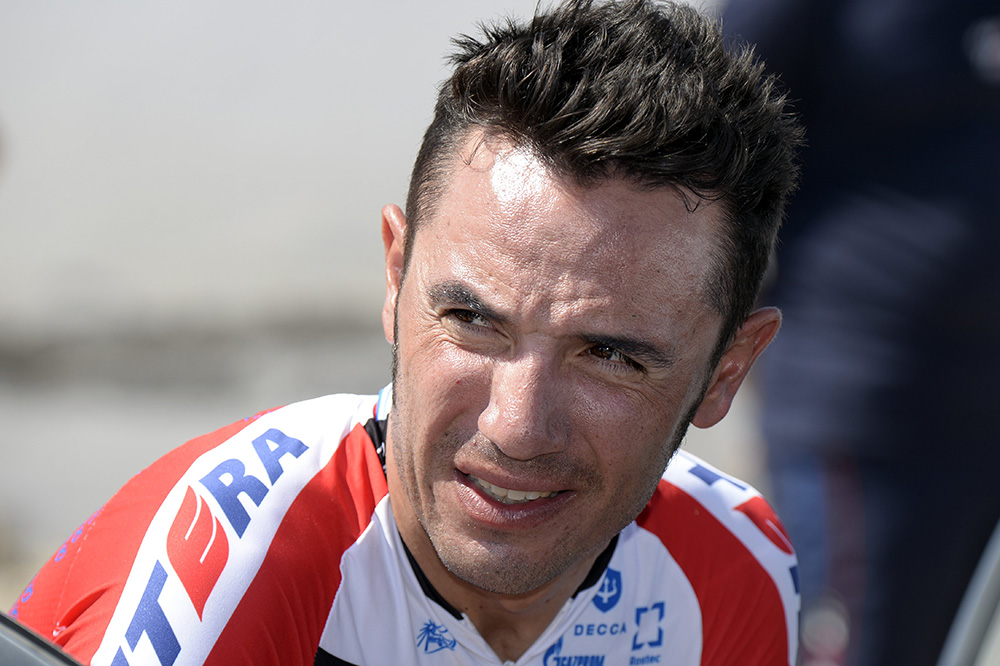 Chris Froome and Alberto Contador renew rivalry in Catalunya as Rodriguez pulls out
Chris Froome and Alberto Contador renew rivalry in Catalunya as Rodriguez pulls outA stomach virus means Joaquim Rodriguez will miss the Volta a Catalunya, but there will be plenty of other contenders for the general classification
By Stuart Clarke
-
 Joaquim Rodriguez to race Tour de France and Vuelta a Espana
Joaquim Rodriguez to race Tour de France and Vuelta a EspanaJoaquim Rodriguez says that the 2015 Tour de France route will suit him
By Gregor Brown